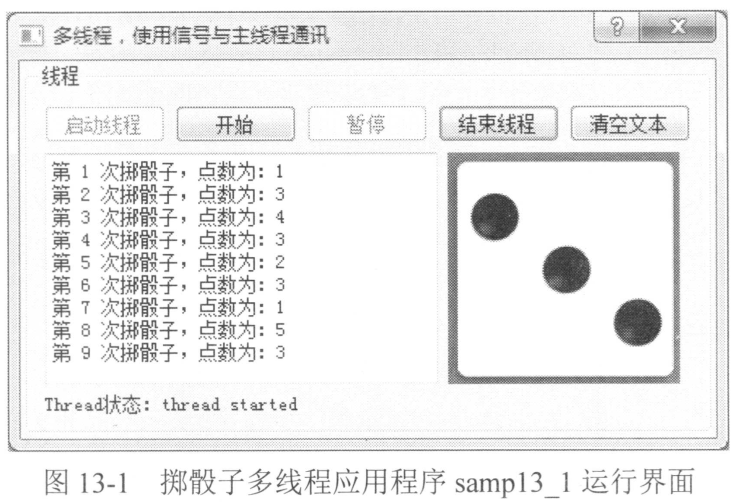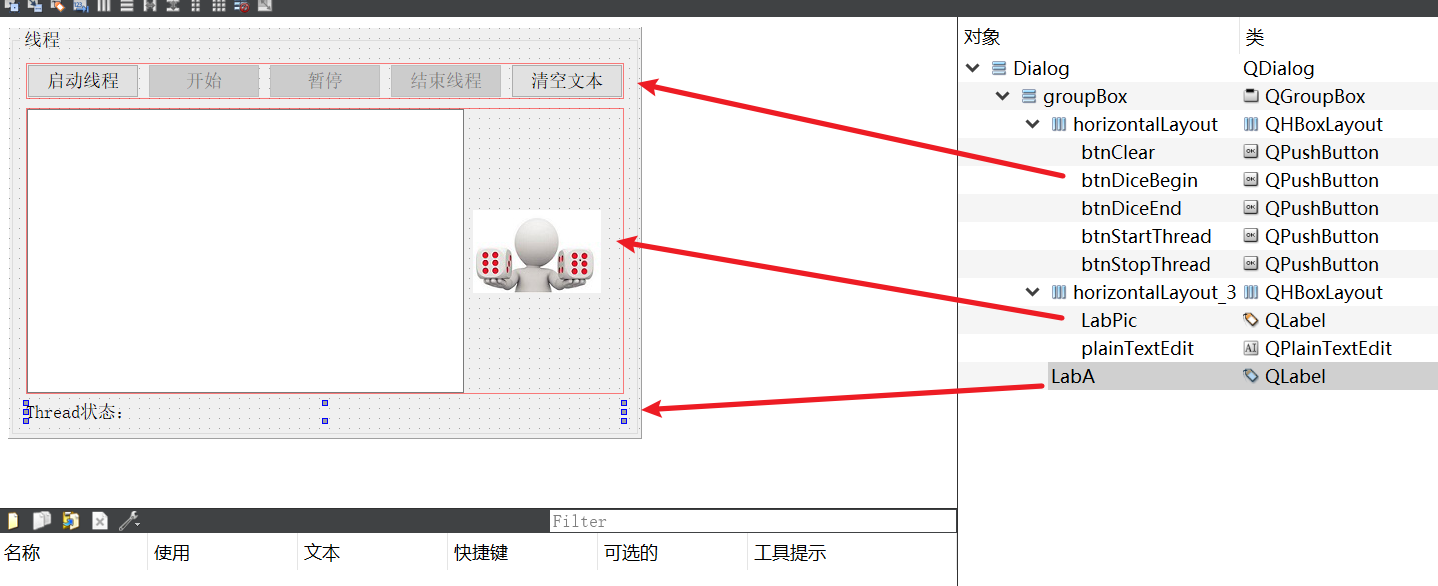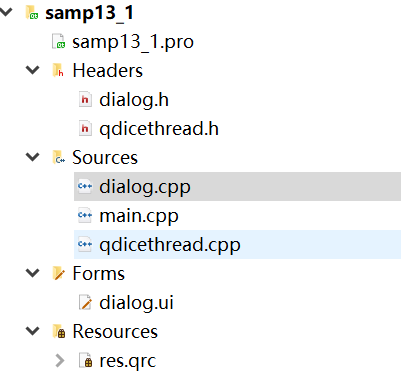一个应用程序一般只有一个线程,一个线程内的操作是顺序执行的,如果有某个比较消耗时间的计算或操作,比如网络通信中的文件传输,在一个线程内操作时,用户界面就可能会冻结而不能及时响应。这种情况下,可以创建一个单独的线程来执行比较消耗时间的操作,并与主线程之间处理好同步与数据交互,这就是多线程应用程序。
Qt 为多线程操作提供了完整的支持。QThread 是线程类,是实现多线程操作的核心类,一般从QThread 继承定义自己的线程类。
线程之间的同步是其交互的主要问题,Qt 提供了 QMutex、QMutexLocker、QReadWriteLock、QwaitCondition、QSemaphore 等多种类用于实现线程之间的同步。
Qt 还有 Qt Concurrent 模块,提供一些高级的 API 实现多线程编程而无需使用 QMutex、QwaitCondition 和QSemaphore 等基础操作。使用Qt Concurrent 实现的多线程程序可以自动根据处理器内核个数调整线程个数。
文章目录
- 1. QThread 类功能简介
- 2. 掷骰子的线程QDiceThread
- 3. 掷骰子的多线程应用程序
- 3.1 可视化UI设计
- 3.2 代码分析
- 3.3 程序结构及源码
- 3.3.1 程序结构
- 3.3.2 qdicethread.h
- 3.3.3 qdicethread.cpp
- 3.3.4 dialog.h
- 3.3.5 dialog.cpp
1. QThread 类功能简介
QThread会起一个子线程,并可以通过信号槽将变量传递到主线程中。
QThread 类提供不依赖于平台的管理线程的方法。一个 QThread 类的对象管理一个线程,一般从QThread 继承一个自定义类,并重定义虚函数run(),在run()函数里实现线程需要完成的任务。
将应用程序的线程称为主线程,额外创建的线程称为工作线程。一般在主线程里创建工作线程,并调用 start()开始执行工作线程的任务。start()会在内部调用 run()函数,进入工作线程的事件循环,在 run()函数里调用 exit()或 quit()可以结束线程的事件循环,或在主线程里调用 terminate()强制结束线程。
QThread 类的主要接口函数、信号和槽函数见下表。


QThread 是 QObject 的子类,所以可以使用信号与槽机制。QThread 自身定义了 started()和finished()两个信号,started()信号在线程开始执行之前发射,也就是在 run()函数被调用之前,finished0信号在线程就要结束时发射。
在进行本章的学习前,建议先复习C++新特性中对应部分,Qt这里就是对C++11的语法进行封装。
2. 掷骰子的线程QDiceThread
作为实例,定义一个掷骰子的线程类QDiceThread,类的声明部分如下:
#ifndef QDICETHREAD_H
#define QDICETHREAD_H#include <QThread>class QDiceThread : public QThread
{Q_OBJECT
private:int m_seq=0;//掷骰子次数序号int m_diceValue;//骰子点数bool m_Paused=true; //掷一次骰子bool m_stop=false; //停止线程
protected:void run() Q_DECL_OVERRIDE; //线程任务
public:QDiceThread();void diceBegin();//掷一次骰子void dicePause();//暂停void stopThread(); //结束线程
signals:void newValue(int seq,int diceValue); //产生新点数的信号
};#endif // QDICETHREAD_H
重载虚函数 run(),在此函数里完成线程的主要任务。
自定义 diceBegin()、dicePause()、stopThread()3 个公共函数用于线程控制,这3 个函数由主线程调用。
定义了一个信号 newValue(int seq,int diceValue) 用于在掷一次子得到新的点数之后发射此信号,由主线程的槽函数响应以获取值。
QDiceThread 类的实现代码如下:
#include "qdicethread.h"
#include <QTime>QDiceThread::QDiceThread()
{}void QDiceThread::diceBegin()
{ //开始掷骰子m_Paused=false;
}void QDiceThread::dicePause()
{//暂停掷骰子m_Paused=true;
}void QDiceThread::stopThread()
{//停止线程m_stop=true;
}void QDiceThread::run()
{//线程任务m_stop=false;//启动线程时令m_stop=falsem_seq=0; //掷骰子次数qsrand(QTime::currentTime().msec());//随机数初始化,qsrand是线程安全的while(!m_stop)//循环主体{if (!m_Paused){m_diceValue=qrand(); //获取随机数m_diceValue=(m_diceValue % 6)+1;m_seq++;emit newValue(m_seq,m_diceValue); //发射信号}msleep(500); //线程休眠500ms}// 在 m_stop==true时结束线程任务quit();//相当于 exit(0),退出线程的事件循环
}
其中,run()是线程任务的实现部分,线程开始就执行 run()函数。run()函数一般是事件循环过程,根据各种条件或事件处理各种任务。当run()函数退出时,线程的事件循环就结束了。
在run()函数里,初始化变量 m_stop 和m_seq,用qsrand()函数对随机数种子初始化。run()函数的主循环体是一个 while循环,在主线程调用 stopThread()函数使 m_stop 为 true,才会退出 while循环,调用quit()之后结束线程。
在 while 循环体内,又根据 m_Paused 判断当前是否需要掷子,如果需要掷骰子,则用随机函数生成一次子的点数 m_diceValue,然后发射信号 newValue(),将 m seq和m diceValue作为信号参数传递出去。主线程可以设计槽函数与此信号关联,获取这两个值并进行显示。
3. 掷骰子的多线程应用程序
使用QDiceThread 类,设计一个应用程序 samp13_1,程序运行界面如下图所示。

窗体上方的几个按钮用于控制线程的启动与停止,控制开始与暂停掷骰子。中间的文本框显示次数和点数,右边根据点数显示资源文件里面的一个图片,图片存储在项目的资源文件里。下方的一个标签根据QDiceThread 的 started()和finished()两个信号显示线程的状态。
3.1 可视化UI设计

3.2 代码分析
窗口类是从QDialog 继承的类 Dialog,其类定义如下(省略了按钮槽函数的定义):
#ifndef DIALOG_H
#define DIALOG_H#include <QDialog>#include "qdicethread.h"namespace Ui {
class Dialog;
}class Dialog : public QDialog
{Q_OBJECTprivate:QDiceThread threadA;protected:void closeEvent(QCloseEvent *event);public:explicit Dialog(QWidget *parent = 0);~Dialog();private slots:
...private:Ui::Dialog *ui;
};#endif // DIALOG_H这里定义了一个QDiceThread 类型的变量 threadA,重定义了 closeEvent()事件,自定义了3个槽函数。
Dialog类的构造函数代码如下:
Dialog::Dialog(QWidget *parent) : QDialog(parent), ui(new Ui::Dialog)
{//构造函数ui->setupUi(this);connect(&threadA,SIGNAL(started()),this,SLOT(onthreadA_started()));connect(&threadA,SIGNAL(finished()),this,SLOT(onthreadA_finished()));connect(&threadA,SIGNAL(newValue(int,int)),this,SLOT(onthreadA_newValue(int,int)));
}
构造函数主要是将 threadA 的 3 个信号与 Dialog 自定义的3 个槽函数相关联,这3 个槽函数的代码如下:
void Dialog::onthreadA_started()
{//线程的started()信号的响应槽函数ui->LabA->setText("Thread状态:thread started");
}void Dialog::onthreadA_finished()
{//线程的 finished()信号的响应槽函数ui->LabA->setText("Thread状态:thread finished");
}void Dialog::onthreadA_newValue(int seq,int diceValue)
{//QDiceThread的newValue()信号的响应槽函数,显示骰子次数和点数QString str=QString::asprintf("第 %d 次掷骰子,点数为:%d",seq,diceValue);ui->plainTextEdit->appendPlainText(str);QPixmap pic; //图片显示QString filename=QString::asprintf(":/dice/images/d%d.jpg",diceValue);pic.load(filename);ui->LabPic->setPixmap(pic);
}
started()信号发射时,表示线程开始执行,在标签里显示状态文字。
finished()信号发射时,表示线程结束执行,在标签里显示状态文字。
newValue()是 QDiceThread 定义的信号,在掷一次骰子获得新的点数后发射,将掷假子的次数和点数传递过来。槽函数onthreadA_newValue()获取这两个值并显示在文本框里,再根据点数从资源文件里获取相应的图片并显示。
窗口上5个按钮的代码如下:
void Dialog::on_btnStartThread_clicked()
{//启动线程 按钮threadA.start();ui->btnStartThread->setEnabled(false);ui->btnStopThread->setEnabled(true);ui->btnDiceBegin->setEnabled(true);ui->btnDiceEnd->setEnabled(false);
}void Dialog::on_btnDiceBegin_clicked()
{//开始 掷骰子按钮threadA.diceBegin();ui->btnDiceBegin->setEnabled(false);ui->btnDiceEnd->setEnabled(true);
}void Dialog::on_btnDiceEnd_clicked()
{//暂停 掷骰子按钮threadA.dicePause();ui->btnDiceBegin->setEnabled(true);ui->btnDiceEnd->setEnabled(false);
}void Dialog::on_btnStopThread_clicked()
{//结束线程 按钮threadA.stopThread();//结束线程的run()函数执行threadA.wait();//ui->btnStartThread->setEnabled(true);ui->btnStopThread->setEnabled(false);ui->btnDiceBegin->setEnabled(false);ui->btnDiceEnd->setEnabled(false);
}void Dialog::on_btnClear_clicked()
{ //清空文本 按钮ui->plainTextEdit->clear();
}“启动线程”按钮调用线程的 start()函数,start()函数会内部调用 run()函数开始线程任务的执行。run()函数将内部变量 m_Paused 初始化为true,所以,启动线程后并不会立即开始掷散子。
“开始”按钮调用 diceBegin()函数,使 threadA 线程内部变量 m_Paused 变为 false,那么run()函数里就开始每隔 500 毫秒产生一次骰子点数,并发射信号 newValue()。
“暂停”按钮调用 dicePause()函数,使 threadA 线程内部变量 m_Paused 变为 true,run()函数里不再掷骰子,但是 run()函数并没有结束,也就是线程并没有结束。
“结束线程”按钮调用 stopThread()函数,使threadA 线程内部的 m_stop 变为 true,run()函数体的 while 循环结束,执行 quit()后线程结束。所以,线程结束就是 run()函数执行退出。
重载closeEvent()事件,在窗口关闭时确保线程被停止,代码如下:
void Dialog::closeEvent(QCloseEvent *event)
{ //窗口关闭事件,必须结束线程if (threadA.isRunning()){threadA.stopThread();threadA.wait();}event->accept();
}
3.3 程序结构及源码
3.3.1 程序结构

3.3.2 qdicethread.h
#ifndef QDICETHREAD_H
#define QDICETHREAD_H#include <QThread>class QDiceThread : public QThread
{Q_OBJECT
private:int m_seq=0;//掷骰子次数序号int m_diceValue;//骰子点数bool m_Paused=true; //掷一次骰子bool m_stop=false; //停止线程
protected:void run() Q_DECL_OVERRIDE; //线程任务
public:QDiceThread();void diceBegin();//掷一次骰子void dicePause();//暂停void stopThread(); //结束线程
signals:void newValue(int seq,int diceValue); //产生新点数的信号
};#endif // QDICETHREAD_H3.3.3 qdicethread.cpp
#include "qdicethread.h"
#include <QTime>QDiceThread::QDiceThread()
{}void QDiceThread::diceBegin()
{ //开始掷骰子m_Paused=false;
}void QDiceThread::dicePause()
{//暂停掷骰子m_Paused=true;
}void QDiceThread::stopThread()
{//停止线程m_stop=true;
}void QDiceThread::run()
{//线程任务m_stop=false;//启动线程时令m_stop=falsem_seq=0; //掷骰子次数qsrand(QTime::currentTime().msec());//随机数初始化,qsrand是线程安全的while(!m_stop)//循环主体{if (!m_Paused){m_diceValue=qrand(); //获取随机数m_diceValue=(m_diceValue % 6)+1;m_seq++;emit newValue(m_seq,m_diceValue); //发射信号}msleep(500); //线程休眠500ms}// 在 m_stop==true时结束线程任务quit();//相当于 exit(0),退出线程的事件循环
}3.3.4 dialog.h
#ifndef DIALOG_H
#define DIALOG_H#include <QDialog>#include "qdicethread.h"namespace Ui {
class Dialog;
}class Dialog : public QDialog
{Q_OBJECTprivate:QDiceThread threadA;protected:void closeEvent(QCloseEvent *event);public:explicit Dialog(QWidget *parent = 0);~Dialog();private slots:void onthreadA_started();void onthreadA_finished();void onthreadA_newValue(int seq, int diceValue);void on_btnClear_clicked();void on_btnDiceEnd_clicked();void on_btnDiceBegin_clicked();void on_btnStopThread_clicked();void on_btnStartThread_clicked();private:Ui::Dialog *ui;
};#endif // DIALOG_H3.3.5 dialog.cpp
#include "dialog.h"
#include "ui_dialog.h"void Dialog::closeEvent(QCloseEvent *event)
{ //窗口关闭事件,必须结束线程if (threadA.isRunning()){threadA.stopThread();threadA.wait();}event->accept();
}Dialog::Dialog(QWidget *parent) : QDialog(parent), ui(new Ui::Dialog)
{//构造函数ui->setupUi(this);connect(&threadA,SIGNAL(started()),this,SLOT(onthreadA_started()));connect(&threadA,SIGNAL(finished()),this,SLOT(onthreadA_finished()));connect(&threadA,SIGNAL(newValue(int,int)),this,SLOT(onthreadA_newValue(int,int)));
}Dialog::~Dialog()
{delete ui;
}void Dialog::onthreadA_started()
{//线程的started()信号的响应槽函数ui->LabA->setText("Thread状态:thread started");
}void Dialog::onthreadA_finished()
{//线程的 finished()信号的响应槽函数ui->LabA->setText("Thread状态:thread finished");
}void Dialog::onthreadA_newValue(int seq,int diceValue)
{//QDiceThread的newValue()信号的响应槽函数,显示骰子次数和点数QString str=QString::asprintf("第 %d 次掷骰子,点数为:%d",seq,diceValue);ui->plainTextEdit->appendPlainText(str);QPixmap pic; //图片显示QString filename=QString::asprintf(":/dice/images/d%d.jpg",diceValue);pic.load(filename);ui->LabPic->setPixmap(pic);
}void Dialog::on_btnClear_clicked()
{ //清空文本 按钮ui->plainTextEdit->clear();
}void Dialog::on_btnDiceEnd_clicked()
{//暂停 掷骰子按钮threadA.dicePause();ui->btnDiceBegin->setEnabled(true);ui->btnDiceEnd->setEnabled(false);
}void Dialog::on_btnDiceBegin_clicked()
{//开始 掷骰子按钮threadA.diceBegin();ui->btnDiceBegin->setEnabled(false);ui->btnDiceEnd->setEnabled(true);
}void Dialog::on_btnStopThread_clicked()
{//结束线程 按钮threadA.stopThread();//结束线程的run()函数执行threadA.wait();//ui->btnStartThread->setEnabled(true);ui->btnStopThread->setEnabled(false);ui->btnDiceBegin->setEnabled(false);ui->btnDiceEnd->setEnabled(false);
}void Dialog::on_btnStartThread_clicked()
{//启动线程 按钮threadA.start();ui->btnStartThread->setEnabled(false);ui->btnStopThread->setEnabled(true);ui->btnDiceBegin->setEnabled(true);ui->btnDiceEnd->setEnabled(false);
}
详细可见附带源码文件



)












)


